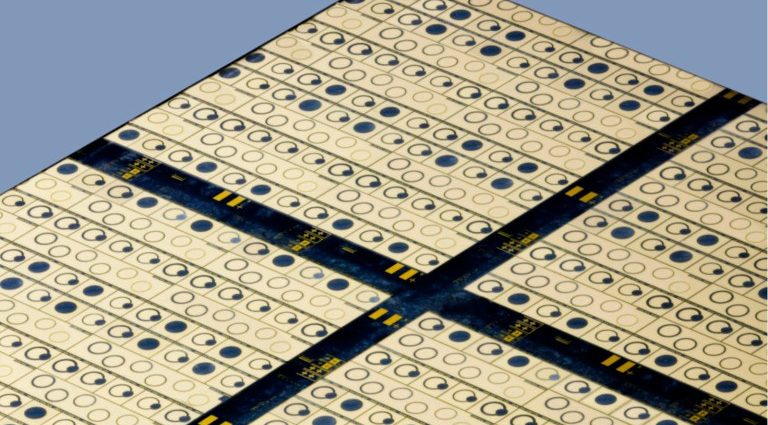Europe’s ST Microelectronics has launched new high-performance gallium nitride (GaN) power devices while Japan’s Rohm plans to buy an old factory in Kyushu and convert it into its largest silicon carbide (SiC) power device production base. Rohm has also started mass production of GaN devices.
China’s recently announced controls on exports of chip-making niche metal gallium should not be a problem for either STMicro or Rohm. But they may become an issue if strident European and Japanese politicians sustain their anti-China rhetoric.
On July 13, STMicro announced that it has begun volume production of GaN high-electron-mobility transistors (HEMT) for use in wall adapters, chargers, lighting systems, industrial power supplies, renewable energy and automotive electrification applications.
The new products deliver better energy efficiency and enable more compact system designs. GaN is touted as third-generation power device material, following first-generation silicon and second-generation SiC.
In addition to producing GaN devices at its factory in Tours, STMicro has them made by TSMC in Taiwan. It began working on the industrialization of GaN in 2018, in cooperation with French research institute CEA-Leti.
SiC is now fast replacing silicon in a massive industry-wide ramp-up of production. Compared with silicon, silicon carbide offers greater energy efficiency and reliability, including resistance to higher voltages, longer device lifetimes and tolerance of a wider range of temperatures and vibration levels.
GaN improves on these advantages but so far lacks economies of scale and may be subject to supply constraints. Starting August 1, Chinese companies wishing to export gallium products will need prior government approval. According to a study by the EU issued earlier this year, China supplies 94% of the world’s gallium.

But the Chinese government has reason to look favorably upon STMicro. In June, the European company and China’s Sanan Optoelectronics announced a joint venture to produce SiC power devices in Chongqing using wafers made by Sanan Optoelectronics. The devices will be supplied to STMicro to meet growing demand from customers in China.
On July 12, Rohm announced that it had agreed to acquire Solar Frontier’s Kunitomi factory in Miyazaki:
Solar Frontier is a Japanese maker of solar panels owned by Idemitsu, a major Japanese oil company. The acquisition is scheduled to be completed in October. Rohm aims to start production of SiC power devices there at the end of 2024.
The 230,000 square meter factory equipped with clean rooms is large enough to cover Rohm’s anticipated production volume through 2030. It will be Rohm’s fourth SiC factory on the island of Kyushu. One of the others is also situated in Miyazaki and two others are in Fukuoka.
Rohm began production of SiC power devices in 2010 but did not launch its drive to become an industry leader until more than a decade later. The company is now targeting a 6.5-times increase in production capacity from 2021 to 2025.
With full use of the Kunitomi factory, it is aiming for a 35-times increase by the end of the decade. Production is also being shifted from 6-inch (150mm) to 8-inch (200mm) wafers.
In Japan, Rohm has developed SiC power semiconductors, sensors and other devices for use in Hitachi Astemo’s inverters and in e-Axle modules developed in a joint venture with Mazda Motor and Imasen Electric Industrial. Applications include engine control, powertrain, ADAS and navigation.
In China, Rohm has formed partnerships with BASiC Semiconductor of Shenzhen to supply power modules and Nanjing SemiDrive Technology to develop and produce devices for vehicle cockpit applications.
Rohm’s sales to China have overtaken its sales to North America and are forecast to account for nearly 15% of total sales this fiscal year. Given the trends in the auto industry, the importance of the China market for Rohm will almost certainly continue to grow.
In Germany, Rohm’s SiC devices have been qualified for use in Semikron’s power modules and will be supplied to Vitesco Technologies, a maker of electrified vehicle drive systems, under a recently signed long-term agreement.
Rohm began working on GaN power devices in cooperation with GaN Systems of Canada in 2018. In May 2023, it announced the start of mass production of HEMT devices similar to those made by STMicro.
These products were developed together with Ancora of Taiwan, an affiliate of power management specialist Delta Electronics. Ancora was established in 2022 to focus on the development of GaN devices.
Rohm appears likely to become a minority shareholder of Toshiba in the buyout by Japan Industrial Partners that was accepted by Toshiba management in March and recommended to shareholders in June.
This should give Rohm access to Toshiba’s power semiconductor technology, particularly as it relates to electric power generation equipment and other heavy electric machinery.

Toshiba’s heavy electrical competitors Mitsubishi Electric and Fuji Electric are also expanding production of SiC power devices.
In March, Mitsubishi Electric announced plans for a five-times increase in capacity by 2026 enabled by the conversion of an obsolete liquid crystal display factory in Kyushu, the expansion of another factory and the construction of a new assembly and packaging facility, also in Kyushu.
Processing of 200mm SiC wafers will be introduced while 150mm wafer production continues to increase. Fuji Electric also plans to build a 200mm SiC wafer line.
Mitsubishi Electric is also increasing output of power semiconductors on standard silicon wafers, with plans to begin mass production using 300mm (12-inch) wafers at its new factory in Hiroshima in 2024.
Explosive growth in output of power semiconductors continues as memory and logic ICs for computing slog through a long and severe cyclical downturn.
Follow this writer on Twitter: @ScottFo83517667

